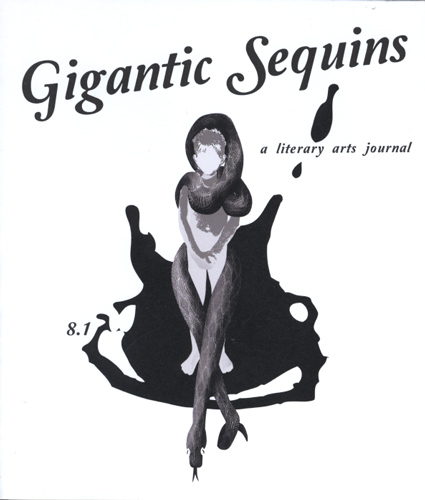Gigantic Sequins – January 2017
The pieces in Issue 8.1 of Gigantic Sequins have an otherworldly quality to them and feel linguistically linked. In her introduction, Editor-in-Chief Kimberly Ann Southwick tells readers that “the fiction in this issue roars and then gives birth,” and I am inclined to extend this metaphor to encompass the poetry and creative nonfiction in the issue as well. The works seem to have a common source with connections to surrealism and themes of nature, violence, blood, and the moon. From p.e. garcia’s opening poem “animal considers animal,” to Craig Chisholm’s review of Anthony Michael Morena’s The Voyager Record: A Transmission (Rose Metal Press, 2016), the issue exemplifies careful editing and consideration in creating a cohesive collection of creative work that stimulates the imagination and lingers long after reading.
The pieces in Issue 8.1 of Gigantic Sequins have an otherworldly quality to them and feel linguistically linked. In her introduction, Editor-in-Chief Kimberly Ann Southwick tells readers that “the fiction in this issue roars and then gives birth,” and I am inclined to extend this metaphor to encompass the poetry and creative nonfiction in the issue as well. The works seem to have a common source with connections to surrealism and themes of nature, violence, blood, and the moon. From p.e. garcia’s opening poem “animal considers animal,” to Craig Chisholm’s review of Anthony Michael Morena’s The Voyager Record: A Transmission (Rose Metal Press, 2016), the issue exemplifies careful editing and consideration in creating a cohesive collection of creative work that stimulates the imagination and lingers long after reading.
The metaphors throughout the works in this issue challenge readers to think critically about life and the current, supercharged atmosphere surrounding world events. Thematic nods to gender identity, terrorism, family, and the precarious natural state of the planet are infused throughout the carefully crafted works. In Dana Fang’s “Feast,” the speaker knows “that kindness is also a kind of / violence,” underscoring disguised deception that so many can and have accepted as truth, and the sadness in the speaker’s voice at the end of the poem reveals the profound effects of gender expectations on the innocent. That sense of hopelessness is also predominant in Andy Myers’s work of short fiction, “The Great Baby Drought,” and the governing mood of dystopian ambiance is almost tangible. In this story, women are “giving birth to things,” and in some instances, things of religious significance that inspire spiritual awakening:
The women who gave birth to copies of The Talmud or The Agamas sought out holy men on mountaintops who offered platitudes about love and war. Despite disappointing reports about these pilgrimages, churches reported record attendance and charities received increased donations.
The narrator relates a number of effects of the baby drought throughout his own story of his wife who gives birth to a plant and the subsequent emotional and physical turmoil this brings. This story and other pieces in the issue provoke assumptions of what it means to be a human on planet earth; they also fulfill the need for the unabashed pleasure of reading finely crafted literary works.
Each piece in this issue turns reality on its head with language both unexpected and alluring. “Jellyfish” by Bailey Pittenger is a work of creative nonfiction ostensibly about a visit to the eye doctor. Although probably more susceptible to a description of such a visit myself as a result of a recent ophthalmologist appointment, I was drawn to this sentence describing the narrator’s view of an image of the retina: “The inside of my eye makes me think of the orange-veined, palm-sized jellyfish I always hold in my palms when I’m in Mississippi.” The comparison is an apt use of language as it engages in a moment of surprise. Poetic language enhances the works of creative nonfiction and fiction in this issue, the result a poetic reading experience from start to finish.
Imagery in the works of poetry is similarly revelatory and intriguing. In “I’M GOING TO BE LATE,” by Paige Lewis, the speaker begins with the following reason: “because I made all the comets sick / by stealing their scarves and the night,” thus compelling a reading of the stanzas that unravel the reasoning as a list of beautiful excuses.
“FOR A BURIAL FREE OF SHARKS,” by Xandria Phillips (and one of the contest winners in the issue), presents a compelling syntactical challenge in its unique use of pronouns and imagery:
/ we worked we wormed / we did our pieces for a burial free of sharks
/ the earth was sand / a sea kind of solid /a half after-life we thought
was better /
This and other poems included in the issue will have me returning to read them again for the sounds of the language as well as for additional turns at decoding layers of meaning.
I would be remiss if I did not point readers to the visual artwork included in Issue 8.1 of Gigantic Sequins. The work of artists Miguel Angel Soto, Sarah Shields, Jason Hart, and Anna McGlynn are worthy of reflection. The entire issue begs readers to revisit the stories, essays, and poems within. The language and literary craft will keep readers on edge and rewarded, as literature of value has always done.
[www.giganticsequins.com]





